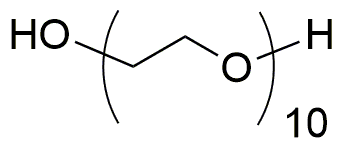Decaethylene glycol is widely utilized in research focused on:
- Cosmetic Formulations: This compound serves as an effective humectant, helping to retain moisture in skin care products, making it ideal for lotions and creams.
- Industrial Applications: It is used as a solvent and plasticizer in the production of plastics, enhancing flexibility and durability in various materials.
- Pharmaceuticals: In drug formulations, it acts as a carrier for active ingredients, improving solubility and bioavailability, which is crucial for effective medication delivery.
- Textile Industry: Decaethylene glycol is employed in textile processing to improve the performance of dyes and finishes, leading to better color retention and fabric quality.
- Surfactants: It is a key ingredient in the production of non-ionic surfactants, which are used in detergents and cleaning products for their excellent emulsifying properties.
General Information
Properties
Safety and Regulations
Applications
Decaethylene glycol is widely utilized in research focused on:
- Cosmetic Formulations: This compound serves as an effective humectant, helping to retain moisture in skin care products, making it ideal for lotions and creams.
- Industrial Applications: It is used as a solvent and plasticizer in the production of plastics, enhancing flexibility and durability in various materials.
- Pharmaceuticals: In drug formulations, it acts as a carrier for active ingredients, improving solubility and bioavailability, which is crucial for effective medication delivery.
- Textile Industry: Decaethylene glycol is employed in textile processing to improve the performance of dyes and finishes, leading to better color retention and fabric quality.
- Surfactants: It is a key ingredient in the production of non-ionic surfactants, which are used in detergents and cleaning products for their excellent emulsifying properties.
Documents
Safety Data Sheets (SDS)
The SDS provides comprehensive safety information on handling, storage, and disposal of the product.
Product Specification (PS)
The PS provides a comprehensive breakdown of the product’s properties, including chemical composition, physical state, purity, and storage requirements. It also details acceptable quality ranges and the product's intended applications.
Certificates of Analysis (COA)
Search for Certificates of Analysis (COA) by entering the products Lot Number. Lot and Batch Numbers can be found on a product’s label following the words ‘Lot’ or ‘Batch’.
*Catalog Number
*Lot Number
Certificates Of Origin (COO)
This COO confirms the country where the product was manufactured, and also details the materials and components used in it and whether it is derived from natural, synthetic, or other specific sources. This certificate may be required for customs, trade, and regulatory compliance.
*Catalog Number
*Lot Number
Safety Data Sheets (SDS)
The SDS provides comprehensive safety information on handling, storage, and disposal of the product.
DownloadProduct Specification (PS)
The PS provides a comprehensive breakdown of the product’s properties, including chemical composition, physical state, purity, and storage requirements. It also details acceptable quality ranges and the product's intended applications.
DownloadCertificates of Analysis (COA)
Search for Certificates of Analysis (COA) by entering the products Lot Number. Lot and Batch Numbers can be found on a product’s label following the words ‘Lot’ or ‘Batch’.
*Catalog Number
*Lot Number
Certificates Of Origin (COO)
This COO confirms the country where the product was manufactured, and also details the materials and components used in it and whether it is derived from natural, synthetic, or other specific sources. This certificate may be required for customs, trade, and regulatory compliance.


